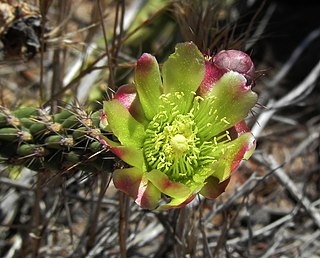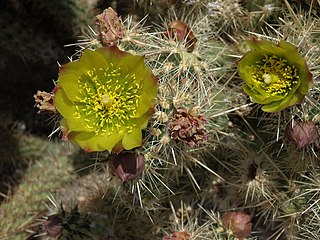
Cylindropuntia fulgida, the jumping cholla, also known as the hanging chain cholla, is a cholla cactus native to Sonora and the Southwestern United States.

Cylindropuntia bigelovii, the teddy-bear cholla, is a cholla cactus species native to Northwestern Mexico, and to the United States in California, Arizona, and Nevada.

Cylindropuntia imbricata, the cane cholla, is a cactus found in the Southwestern United States and northern Mexico, including some cooler regions in comparison to many other cacti. It occurs primarily in the arid regions of the Southwestern United States in the states of Kansas, Oklahoma, Texas, New Mexico, Arizona, Colorado, and Nevada. It is often conspicuous because of its shrubby or even tree-like size, its silhouette, and its long-lasting yellowish fruits.

Cylindropuntia is a genus of cacti, containing species commonly known as chollas, native to northern Mexico and the Southwestern United States. They are known for their barbed spines that tenaciously attach to skin, fur, and clothing. Stands of cholla are called cholla gardens. Individuals within these colonies often exhibit the same DNA, as they were formerly tubercles of an original plant.

Grusonia is a genus of opuntioid cacti, originating from the North American Deserts in Southwest United States and northern Mexico, including Baja California. Authors differ on precise boundaries of the genus, which has been included in Cylindropuntia. Corynopuntia, also known as club chollas, is now a synonym, with the genus originally being described by Knuth in 1935. Molecular phylogenetic studies suggest that it should be included in Grusonia, a view accepted by Plants of the World Online as of June 2021.

Cylindropuntia echinocarpa is a species of cactus known by the common names silver cholla, golden cholla, and Wiggins' cholla. It was formerly named Opuntia echinocarpa.

Grusonia parishiorum is a species of cactus known by the common names matted cholla and Parish club cholla. It is native to the Mojave and Sonoran Deserts of California and Arizona.

Cylindropuntia californica is a species of cholla cactus known by the common name snake cholla. It is primarily found in Baja California, Mexico and the southernmost part of California in the United States. It is characterized by a short, decumbent habit, yellow-green flowers, elongated stems, and short spines. It is mostly found in coastal sage scrub and coastal chaparral habitats, but two varieties in Baja California can be found in foothills and deserts. In California, variety californica is regarded as a rare and threatened plant, with a California Native Plant Society listing of 1B.1, in part due to its limited number of occurrences and threats from development. It formerly was considered to have a larger range due to the inclusion of Cylindropuntia bernardina within it as the variety parkeri.

Cylindropuntia prolifera, known by the common name Coastal cholla, is a species of cactus. In Australia it is called 'Jumping Cholla' because of it seeming to jump from outbreak to outbreak.

Cylindropuntia ramosissima is a species of cactus known by the common names diamond cholla and branched pencil cholla.

Cylindropuntia leptocaulis, the desert Christmas cactus, desert Christmas cholla, pencil cactus, or tasajillo, is a species of cholla cactus.

Echinocereus viridiflorus is a species of cactus known by the common names nylon hedgehog cactus, green pitaya, and small-flowered hedgehog cactus. It is native to the central and south-central United States and northern Mexico, where it can be found in varied habitat types, including desert scrub, woodlands, dry grasslands, and short-grass prairie.

Cylindropuntia spinosior, with the common names include cane cholla, spiny cholla and walkingstick cactus, is a cactus species of the North American deserts.
Moneilema semipunctatum is a species of beetle in the family Cerambycidae. It was described by John Lawrence LeConte in 1852. It is known commonly as the cactus borer beetle. Beetles of genus Moneilema are known commonly as cactus longhorn beetles. It is native to North America, where it occurs in the western United States and Mexico.

Cylindropuntia whipplei is a member of the cactus family, Cactaceae.
Cylindropuntia abyssi, common name Peach Springs cholla, is a species of cactus endemic to northwestern Arizona. It is known from only from the Grand Canyon and in Peach Springs Canyon, on the Hualapai Reservation in Mohave County. It grows in desert scrub on limestone ledges and hilltops. The natural range of the species is fairly small, but it is locally abundant and growing in an isolated area with few threats to the species survival.
Flora of the Sonoran Desert includes six subdivisions based on vegetation types. Two are north of the boundary between the United States and Mexico, and four are south of the boundary. The flora of the Colorado Desert are influenced by the environment of the very dry and hot lower areas of the Colorado River valley, which may be barren, treeless, and generally have no large cacti. Flora of the Arizona Upland are comparatively lush, with trees and large columnar cacti that can withstand winter frosts. Those subdivisions of the Sonoran Desert which lie south of the international border are characterized by plants that cannot withstand frost.

Cylindropuntia fosbergii is a species of cactus known by the common names Hoffmann's teddybear cholla, pink teddy-bear cholla, and Mason Valley cholla. It is endemic to south-eastern California where its range is restricted to the flats and hillsides of a very limited area in the region of Anza-Borrego Desert State Park in the western Sonoran Desert.

Cylindropuntia bernardina is a species of cholla cactus commonly known as the cane cholla or valley cholla, native to California and northwestern Baja California. It is an erect cholla that grows up to 2–3 meters tall, and occurs primarily in the foothills of the Transverse and Peninsular Ranges, parts of the Sonoran Desert, and in the Coast Ranges with a few populations around the Cuyama River. It was formerly placed as the variety parkeri of Cylindropuntia californica until it was renamed to C. bernardina. It is more closely related to Cylindropuntia ganderi than to C. californica.
















